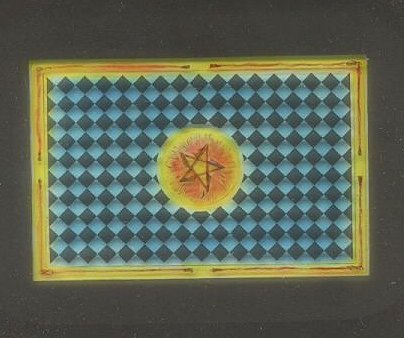 Mosaic of five-pointed star on Lodge floor
Mosaic of five-pointed star on Lodge floorThis checker-board floor represents various laws. On one level this represents the laws of nature and equilibrium. Masons call this floor a tesserated design from the Greek and Latin description of a "pattern of cubes". The root word is Tessera, for a mason "perfected" or squared on six sides. After all, they are the "Stones the Builder Rejected". The Tessera, later called Tessla by the Romans was a cube with messages and password inscribed and used by the military. The modern form is a dice. Nikoli Tessla, the scientist has a typically humerous masonic name, for in old English the devil is commonly referred to as "Old Nick" while Tessla speaks for itself. The Knights (Kay-nights) Templar used a floor such as this on which they, being the world's largest banking institution, played their game-of debt and credit. Chess used to be called chequers and from this we have the banking cheque of today. The British Parliament calls the minister in charge of the treasury(taxes) the Chacellor of the H-Chequer. The old Templar buildings are still used by the Law Society and Temple Square houses the national banks. In the square centre stands an Egyptian Obelisk.
The ancient game of CHESS was invented in India. In disagreements, there always must appear to exist clear divisions; one side being in favor, another is against. Also, it was understood that most wars or debates are disputed by individuals or groups who view themselves as being on the side of God. Likewise. adversaries usually equate their opponents to the devil.
Therefore each side in CHESS was given a natural color; one white the other black. As in politics, playing either color is allowed. Clearly under these rules, if leaders lack integrity - every game can be manipulated and the end results always predicted.
For the game of political illusion to function properly two publicly accountable leaders who in reality are cosmetic and powerless, must be positioned to head both teams. This explains why in CHESS the game revolves around the piece called the KING. The king piece, like all monarchs or elected politicians, is kept in the dark; ostensibly for the sake of security. In real life, a triage or sorting of the information public leaders receive occurs prior to being viewed.
In CHESS, as in politics, the King piece is only allowed to move one square at a time. Obviously, due to these limitations, he has no real power to affect the final outcome of the game. If the "leader" is quick enough, or dumb enough, he can delay only the inevitable.
Real power within the game, as in politics, rests in the piece we call the QUEEN. This is a man dressed as a woman (Gay?) who moves almost at will anywhere among the board. The piece acts in a way similar to a real life deputy minister; one who is accountable to the public but who none-the-less manages the "government game" by skillfully awarding or withholding all promotions and contracts (bribes and blackmail). The Queen never plays "his" own moves. He always plays his role in the game only on behalf of the HIDDEN HAND who pulls his strings.
The next two most important pieces in the game are KNIGHTS. Both were deemed to symbolize the advantages gained when applying just the right amount of physical violence (force). Knights, much like the military and organized crime, do not play the game by the same rules as do the other pieces. They can jump over their enemies to attack them from the rear. This is contrary to the rules of fair play that govern the moves of other pieces in the game.
The next two pieces which the game's designer positioned on his CHESS board were BISHOPS. These pieces may only move sideways, diagonally, in any direction. They signify the power obtained by the player because of the existence of a controlled national organized religion that functions in concert with a controlled national media. By national media the CHESS game designer also meant al "public education" as well as both the book publishing and entertainment industries.
Their combined purpose is to prevent popular revolution; by deflecting citizen dissent. In a timely manner they demonize - to "manufacture hate". This hate, which they insist is only "public opinion", is then used against every detractor who dares expose the HIDDEN HAND that controls them both.
Then, he positioned both ROOKS. They are the sold fortresses constructed of, and by, masonry. Both serve to enforce the puppeteer's orders. These two pieces are, of course, synonymous with national governments and trans-national corporations. Both of these banker controlled corporate entities waste, or steal, each nation's resources. They do this consciously in order to perpetuate poverty.
The pain inflicted by poverty is then marketed by the national media. It is used to frighten the middle class. Because of this fear, ordinary people obey orders blindly and are easily controlled by the elites. The poor are in turn, controlled by welfare programs.
The remaining pieces the master designer of the game chose to position, dangerously, at the front of the other more powerful pieces. They are the pawns. They outnumber any other piece. They are the cannon fodder defend the elites with their lives. These relatively inexpensive pieces who, because naivete, greed, avarice or vanity, allow the secret HIDDEN HAND to use their lives in his game plan. Their own power usually lasts only as long as they suit his purpose.

